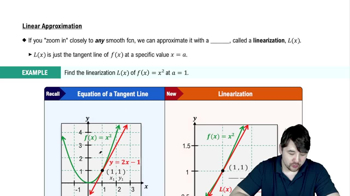Table of contents
- 0. Functions7h 52m
- Introduction to Functions16m
- Piecewise Functions10m
- Properties of Functions9m
- Common Functions1h 8m
- Transformations5m
- Combining Functions27m
- Exponent rules32m
- Exponential Functions28m
- Logarithmic Functions24m
- Properties of Logarithms34m
- Exponential & Logarithmic Equations35m
- Introduction to Trigonometric Functions38m
- Graphs of Trigonometric Functions44m
- Trigonometric Identities47m
- Inverse Trigonometric Functions48m
- 1. Limits and Continuity2h 2m
- 2. Intro to Derivatives1h 33m
- 3. Techniques of Differentiation3h 18m
- 4. Applications of Derivatives2h 38m
- 5. Graphical Applications of Derivatives6h 2m
- 6. Derivatives of Inverse, Exponential, & Logarithmic Functions2h 37m
- 7. Antiderivatives & Indefinite Integrals1h 26m
- 8. Definite Integrals4h 44m
- 9. Graphical Applications of Integrals2h 27m
- 10. Physics Applications of Integrals 2h 22m
4. Applications of Derivatives
Linearization
Problem 4.6.13
Textbook Question
Estimating speed Use the linear approximation given in Example 1 to answer the following questions.
If you travel one mile in 59 seconds, what is your approximate average speed? What is your exact speed?
 Verified step by step guidance
Verified step by step guidance1
To estimate the speed, we can use the concept of linear approximation. Linear approximation is a method of estimating the value of a function near a given point using the tangent line at that point.
First, identify the function that relates distance and time. The speed is the derivative of the distance with respect to time. If we denote distance as \( s(t) \) and time as \( t \), then speed \( v(t) \) is given by \( v(t) = \frac{ds}{dt} \).
Given that you travel one mile in 59 seconds, we can set up the function \( s(t) = t \) where \( s(t) \) is in miles and \( t \) is in seconds. The derivative \( \frac{ds}{dt} = 1 \) mile per second.
To find the approximate average speed, convert the time from seconds to hours since speed is typically measured in miles per hour. There are 3600 seconds in an hour, so the time in hours is \( \frac{59}{3600} \) hours.
Finally, calculate the approximate average speed using the formula \( \text{Speed} = \frac{\text{Distance}}{\text{Time}} \). Substitute the values: \( \text{Speed} = \frac{1 \text{ mile}}{\frac{59}{3600} \text{ hours}} \). This will give you the approximate average speed in miles per hour. For the exact speed, use the same formula without approximation.
 Verified video answer for a similar problem:
Verified video answer for a similar problem:This video solution was recommended by our tutors as helpful for the problem above
Video duration:
2mPlay a video:
Was this helpful?
Key Concepts
Here are the essential concepts you must grasp in order to answer the question correctly.
Linear Approximation
Linear approximation is a method used to estimate the value of a function near a given point using the tangent line at that point. It relies on the idea that for small changes in the input, the function can be approximated by a linear function. This is particularly useful in calculus for estimating values without needing to compute them exactly.
Recommended video:

Linearization
Average Speed
Average speed is defined as the total distance traveled divided by the total time taken. It provides a measure of how fast an object is moving over a specific interval. In this context, if you travel one mile in 59 seconds, the average speed can be calculated by converting the distance and time into consistent units, typically miles per hour.
Recommended video:

Average Value of a Function
Exact Speed
Exact speed refers to the precise measurement of speed at a specific moment or over a specific distance and time. In contrast to average speed, which considers total distance and time, exact speed can be determined using calculus concepts such as derivatives, which provide instantaneous rates of change. This allows for a more accurate representation of speed at any given point.
Recommended video:

Derivatives Applied To Velocity
Related Videos
Related Practice



